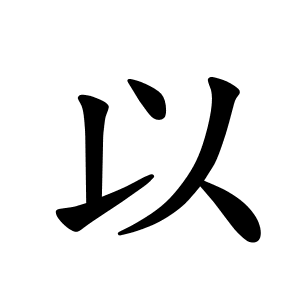以
- to use, employ;
- by means of, through, with (prepositional use);
- because of, due to (reason);
Etymology
Pictograph, later phono-semantic reinterpretation:
Oracle bone script (甲骨文): drawn as a coiled line or cord, interpreted as a navel cord / umbilical cord (something connecting or used as a means).
Bronze & Seal script (金文·篆書): form stabilized, later with the addition of 人 (person) on the side.
Modern form: often explained as 女 (woman) + 人 (person) in Cangjie input, but the true origin is the cord/means image.
Thus: originally a pictograph of a cord, later extended to mean “to use, to take as a means.”
Usage in Korean
In modern compounds:
可以 (가이) — can, may
得以 (득이) — to manage to, be able to
以後 (이후) — after, from now on
以外 (이외) — outside of, except
Classical Chinese constructions:
以AB → “to do B with A”
是以B → “therefore B” (literally: “for this reason, B”)
以A爲B → “to take A as B, regard A as B”
所以B → “the reason/method for B” (literally: “that by which…”)
Words that derived from 以
Additional notes
Mentioned in 《說文解字》 (Shuōwén Jiězì) by Xu Shen as: 「以, 用也」 — “以 means to use.”
Korean grammar distinguishes 로서 vs. 로써, but Classical Chinese 以 covers both.
Plays a role similar to the modern Chinese structural particle 把 (bǎ) in some contexts.
Alternative forms
㠯, preserving the earlier shape.
- 女戈人 (VIO)
- ⿲ 𠄌 丶 人
- ⿲⿱ 丨 ㇀ 丶 人
